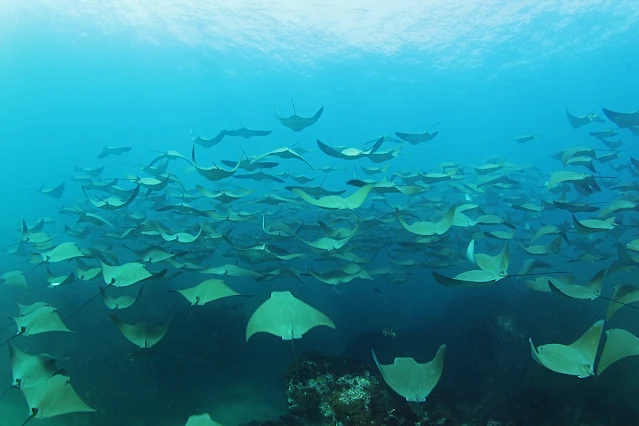The Cownose Ray (Rhinoptera bonasus) is a fascinating and highly migratory species of eagle ray found in warm coastal waters of the Atlantic Ocean. Named for its distinctive, cow-like snout, this ray is known for its gentle nature, schooling behavior, and crucial role in marine ecosystems.
Physical Characteristics:
Cownose Rays have a unique diamond-shaped body with long, pointed pectoral fins that allow them to glide gracefully through the water. Their defining feature is their broad, rounded head, resembling a cow’s nose when viewed from above.
Size: Typically between 2 to 3 feet (0.6 to 0.9 meters) in width, though they can grow up to 4 feet (1.2 meters).
Weight: They usually weigh around 25 to 50 pounds (11 to 23 kg).
- Color: Their dorsal (top) side is brown to olive-green, while the ventral (underside) is pale, helping them blend into their surroundings.
- Tail: Unlike stingrays, their tail is relatively short but contains a mildly venomous barb, used primarily for defense.
A ray reaching a span of 84 inches has been recorded. The cownose ray (Rhinoptera bonasus) is a species of eagle ray found throughout a large part of the western Atlantic and Caribbean, from New England, United States to southern Brazil (East Atlantic populations are now generally considered a separate species, R. marginata). Cownose rays grow rapidly, and male rays often reach about 35 inches (89 cm) in width and weigh 26 pounds (12 kg). Females typically reach 28 inches (71 cm) in width and weigh 36 pounds (16 kg).
Habitat and Distribution:
Cownose Rays inhabit shallow coastal waters, estuaries, and bays in the western Atlantic Ocean, ranging from New England and the Gulf of Mexico down to Brazil. They prefer warm, brackish waters and are often found swimming in large schools near the surface.
Behavior and Migration:
- Spring Migration: They move northward from Florida and the Gulf of Mexico toward the Chesapeake Bay and the Atlantic coastline.
- Autumn Migration: As temperatures drop, they return southward to warmer waters.
Cownose Rays are bottom-feeders, using their specialized plate-like teeth to crush hard-shelled prey. They use their wing-like fins to stir up the sandy ocean floor, exposing buried shellfish before crushing them with their strong jaws.
The cownose ray feeds upon clams, oysters, hard clams and other invertebrates. It uses two modified fins on its front side to produce suction, which allows it to draw food into its mouth, where it crushes its food with its dental plates. Cownose rays typically swim in groups, which allows them to use their synchronized wing flaps to stir up sediment and expose buried clams and oysters.
Reproduction and Lifespan:
Cownose Rays are viviparous, meaning they give birth to live young instead of laying eggs.
Gestation period: About 11 to 12 months.
Birth rate: Females typically give birth to one pup per year.
Lifespan: They can live up to 18 years in the wild.
Ecological Importance:
Cownose Rays play a vital role in marine ecosystems by maintaining balance within the food chain. However, their feeding habits can sometimes lead to conflicts with shellfish industries, as they consume large amounts of oysters and clams.
Threats and Conservation:
Despite their resilience, Cownose Rays face several threats:
Overfishing: They are sometimes targeted due to misconceptions about their impact on shellfish populations.
Habitat Loss: Coastal development and pollution can reduce their natural feeding and breeding grounds.
Climate Change: Rising ocean temperatures and habitat shifts may affect their migratory patterns.
Conservation Efforts:
Organizations and researchers are working to better understand and protect Cownose Rays. Some efforts include:
Promoting sustainable fishing practices.
Conducting population studies to monitor migration patterns.
Raising awareness to dispel myths about their role in shellfish declines.
Interaction with Humans:
Cownose Rays are harmless to humans and generally avoid direct contact. Unlike stingrays, they are not aggressive, and their venomous barb is rarely used. Many aquariums feature interactive exhibits where visitors can touch and learn more about these gentle creatures.
Final Thoughts:
The Cownose Ray is a graceful and essential part of the marine ecosystem. Their migratory behavior, unique feeding habits, and gentle nature make them a species worth protecting. By understanding and conserving these rays, we ensure that they continue to thrive in our oceans for generations to come.




No comments:
Post a Comment
Stay updated with our blog for more quality content! Your feedback is appreciated. Contact us at harshrex@outlook.com with any suggestions.